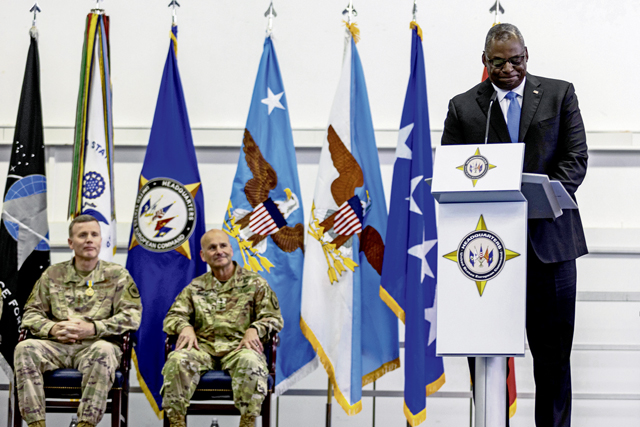
Secretary of Defense Lloyd J. Austin III presided as Air Force Gen. Tod Wolters passed command of the U.S. European Command to Army Gen. Christopher Cavoli in a ceremony at Patch Barracks, July 1.
Austin said the change of command for the combatant command is happening “at a hinge in history.”
The Russian invasion of Ukraine has shattered the peace that U.S. European Command helped shepherd through 70 years of the Cold War, the dissolution of the Soviet Union, and the post-9/11 era.
“Russia’s premeditated malice and baseless aggression against Ukraine poses the gravest threat to European security since the end of World War II,” Austin said. “And [Russian President Vladimir] Putin’s war of choice threatens more than just the sovereignty of Ukraine: It’s an assault on transatlantic peace and security. It’s a reminder that tyrants believe that their imperial appetites matter more than the rights of their peaceful neighbors.”
Austin said the command is a center for the effort to defend freedom, democracy and human rights from autocrats who see free systems of self-government as relics of the past. “In this hour of danger, I’m incredibly proud of the way that this command has stepped up.”
The secretary said the command has been integral in rushing security assistance to Ukraine, “harmonizing your efforts with NATO as the alliance sends thousands of additional troops to its eastern flank. And, together with our allies and our partners around the world, you’re meeting Russian aggression with unity, with spine, and with steel.”
The command includes more than 100,000 U.S. service members, whose presence reassures the nations of Europe that the United States will work with allies and partners to defend every inch of NATO territory, said Army Gen. Mark Milley, chairman of the Joint Chiefs of Staff.
“Those troops are standing watch right now during one of the most pivotal and dangerous times in our lifetimes,” he said. “They are supporting Ukraine as Ukraine fights to defend their nation and their sovereignty.”
Milley noted the strategic complexity of the region, which includes more than 50 countries and territories and a billion people speaking 200 different languages. The area generates $23 trillion.
“European Command is part of a much larger team of teams that includes all the countries of NATO and many that are not part of NATO,” Milley said. He called Eucom a strand in the rope of allies and partners in the region.
Both Austin and Milley noted all that Wolters contended with during his command — from COVID-19 to Afghanistan to Russia to increasing threats from China. The chairman presented Wolters with the Defense Distinguished Service Medal for his service in command.
The defense leaders also said that Cavoli is the right leader at the right time, after serving as the commander of U.S. Army Europe and Africa.
Cavoli thanked Wolters for his leadership of the U.S. European Command and said he’ll build on the Wolter’s legacy.
“Back in 1952, the very first [supreme allied commander, Europe] was stepping down, and, in his farewell to NATO, [Army] Gen. Dwight Eisenhower said that he and the alliance’s leaders had shared ‘the same passionate hope of serving free humanity… [and] of making it secure,’” Austin said. “We still share that hope. We still keep that flame burning.”
Austin said future generations will remember this moment in history. “They’ll take inspiration from the resilience and the valor of the people of Ukraine,” he said. “They’ll take heart from the way that nations of good will rallied against Putin’s aggression. They’ll remember the way that we moved to defend every member of NATO. They’ll recall the way that we renewed the institutions and alliances that deepen our shared security. And they’ll draw strength from that ‘same passionate hope of serving free humanity’ and our struggle to make it secure.”


